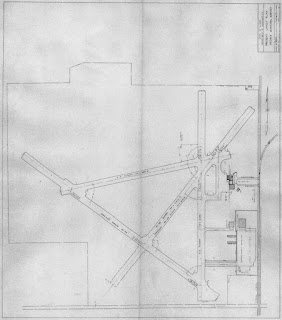PIA – A History: Air Service Returns (1945)!
The previous installment of this series covered efforts to improve Peoria’s Municipal Airport so that commercial airline service could be restored. Now, we will detail the actual restoration of service in 1945.
RESUMPTION OF FLIGHTS
In 1942, the Air Transport Command was formed to coordinate air freight and passenger service with the airlines. Personnel involved with the war effort were given priority, thus limiting air travel for the general public. By early 1945, an Allied victory over Nazi Germany seemed assured so commercial airline service could once again primarily cater to the general public.
Since both American Airlines and Chicago & Southern Air Lines retained Peoria on their respective operating certificates, the only hurdle prior to resumption of flights was completion of a new terminal. By early April, representatives of the two carriers agreed to resume flights on May 1, 1945 as that was the estimated completion date for the terminal building.
A Peorian, Captain Robert D. Morgan, became the first passenger when he boarded a Chicago & Southern Air Lines DC-3 at Chicago Municipal Airport. It should be noted that Morgan served as Peoria mayor from 1953 to 1957. After the first American Airlines DC-3 touched down at 2:39pm on that Tuesday afternoon, it was christened Flagship Peoria.
Service had to be suspended for a week beginning May 18 due to lack of a radio beam. The Peoria Morning Star reported the next day that service was expected to resume the following Friday (May 25) when the beam was installed. A four-way radio range went into operation on July 11, enabling aircraft to land when the ceiling was as low as 500 feet. The previous limit had been 1000 feet.
A FIRST-CLASS AIRFIELD
The diagram below is dated June 15, 1945. There appear to be two errors: First, NW-SE Runway 12-30 is shown to be 5,000 feet in length, when it was actually about 4,002 feet until a 1947 extension was required for operation of F-51 Mustangs by the new 169th Tactical Fighter Group of the United States Air National Guard. Second, the LeTourneau hangar seen on the east side of the airfield and south of the administration building/terminal and Rohn Flying Service hangar was completed in January 1946. In reality, this diagram appears to be a master plan showing both the existing facility and future development.
SCHEDULES
With resumption of daily service on May 1, 1945, American Airlines and Chicago & Southern Air Lines initially gave the Peoria Municipal Airport eight flights daily, all operated with DC-3s. The following schedule shows scheduled flights operated during the summer.
SPRINGFIELD STOP ABSENT
Springfield’s airfield, located on Chatham Road southwest of the city, was expanded in 1937 but nearby railroad lines inhibited further growth. Aircraft were restricted to no more than 15 passengers, precluding profitable operation by DC-3s. American Airlines dropped service on November 16, 1938 and Chicago & Southern Air Lines ended service in November 1939. Upgrades led to restoration of C&SA service on June 10 that year, but service continued only until November 10, 1940. Construction of a new airfield was delayed by the Second World War, and operations at the new “Capital Airport” would not commence until November 2, 1947. For more, see Mike Kienzler’s Sangamon History blog on Springfield aviation history.
So as Peoria and the nation looked forward to world peace, commercial airline service had been restored. Within a couple of years, the city’s airport would gain an additional hangar, runway extensions and widening, equipment for all-weather and night flying, a third airline and a permanent military presence. These and more will be covered in future installments of this series.
– David P. Jordan



Comments
Post a Comment